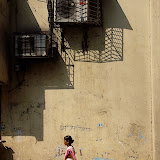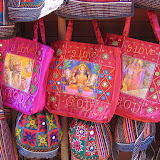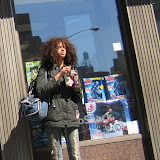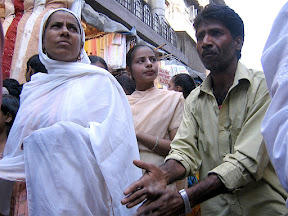Tokyo – Bombay: Urban Contrast
On this trip back to Bombay to visit my family, I stopped in Tokyo for four days to visit a close friend of mine, Parikshat (PK) and his wife Keiko. PK and I were in Campion School together. In 7th grade we sat next to one another, and we have been close friends ever since. PK and Keiko met when he was doing an internship with IBM in Tokyo. They have been living there six years after spending a few years in the US.
Tokyo is one of the few places I have been that seems almost as crowded and bustling as Bombay. The similarities between these two places stops there though. As we are landing, I am struck by how small and dense everything is. The roads, the cars, the buildings, the parking lots, all seem half the size of what I am accustomed to in the US. Everything is neatly laid out to make the most efficient use of space. There is reason for that: Japan has half the population of the US in an area that is one-twenty-fifth its size. Take this population size and squeeze them into a group of small islands and you will end up with one of the most densely populated countries and a smart use of space. It also leads to a highly structured and polite society where your space in the social landscape is explicitly and implicitly bounded.
The bus from Narita airport into Tokyo drops me at the Cerulean Tower hotel in Shibuya. As I sit in the lobby on a late weekday evening, I notice that all the businessmen wear almost identical dark suits. No blue shirts, only white or cream, and I do not see a yellow or red tie. PK walks up to me in a dark suit, big smile and a bold red scarf around his neck. It has been years since we have met but in a few minutes the banter turns to engaged conversation.
Out on the street in Shibuya, I feel like I am in a
scene from
"Lost in Translation", the crowds streaming across the
crossroads, bright neon ads reflecting off the tall glass buildings. We head underground into the subway station. Commuters stand silently in line and patiently wait for others to exit before they take turns squeezing aboard the already packed train. This is where I learn my first Japanese word - Sumimasen - which I hear (and use) many, many times during my trip. It means excuse me; and also, I am sorry. Contrast this politeness with Bombay where the concept of waiting your turn is non-existent.
Ghusao – push to get your way or you will miss the train. And the louder your voice and angrier you sound gets you further.
The second word I learn is Arigatto-gozaimas: thank-you, which I learn to say as well as act - a short bow at the waist, followed by a dip of the head. The deeper you go, the more respect you convey. I enjoy learning these new words and ways. I roll the words around in my mouth and mind, unfamiliar yet compelling. In the next four days I enjoy trying to learn to say the names of the places I visit in Tokyo. I invariably butcher them – mixing and matching the mouthful of strong vowels and consonants, eliciting laughs from Keiko and sympathy from PK. Shibuya becomes Shibuyu. Takeshitadori, Takashidora. Harajuku, Harukuja. Kamakura, Kamaguru. One of the highlights of my trip is visiting the Ukiyo-e Museum. Ukiyo-e is a uniquely Japanese style of artistic woodblock printmaking that was prominent in metropolitan Edo era Japan of the 18th and 19th centuries. Ukiyo-e translates to - pictures of a floating world - from the Buddhist belief that the physical world around us is phenomenal and impermanent. The printing technique calls for the original drawing to be destroyed in the process of making a woodblock that is used over and over to make multiple prints. These affordable prints made the art accessible to the urban populace, often showing iconic urban and natural scenes that an ordinary person could connect with and relate to. As I look at the prints, I am struck how modern they are in sensibility and in graphic product. The European impressionists and post-impressionists were inspired by this art form when they discovered it in the early 20th century. I have found a new passion, art that I enjoy for its
deep rich color,
crisp graphic lines and a supreme use of
framing and perspective. It reminds me of another favorite art-form: comics - especially
TinTin and
Asterix that I grew up reading.
If Tokyo is big, but respectful and polite, Bombay is big, brash and chaotic. It is like the contrast between the crisp ukiyo-e prints and the riotously colorful
Amar Chitra Katha comics I also grew up reading. These comics have colors that are hyper-realistic, the
stories fantastical and over the top. They jump off the page, filled with emotion and inconsistency: a reflection of the organic mess that is India.
As I walk out of the convoluted passageways of Sahar airport to the parking lot, my ears are assaulted by the din of taxi horns and bollywood ringtones. I dodge the shifting, milling pockets of relatives, the pushy taxi drivers looking to fleece their next fare, the lone policeman disinterestedly watching the chaos, casually spitting
paan in the dusty bushes behind him. The night air is humid and ripe. I look at the chaos around me and finally see Mimo making his way through the crowd, eyes bright, his whole body smiling. I have arrived.
Back at B-2 Palacimo, mom, dad and I are all smiles and chatter. I unpack all the goodies, gifts and gadgets and then fall into jet-lagged sleep in the room I grew up in.
Mimo and Nazneen are busy the next day preparing for the Christmas party they are hosting at my dad's office. Cole Paints & Contracts Pvt. Ltd. is located in Kala Ghoda, south Bombay in an old building on the floor above Rhythm House music store. Kala Ghoda literally means black horse, named for a statue of a British dignitary sitting astride a horse that use to stand in the open plaza. The statue is long gone and the area is now a surface parking lot. I spend my time walking through the Kala Ghoda arts district, noticing the new galleries, shops and restaurants. Sadly, one of my favorite haunts, Madras Café, is boarded up. Bombay, like all big cities, molts, evolves, decays, renews and each visit has a fresh surprise. By the time I return to the office, Naz has transformed the back room from a plain drab space that had desks for clerks and accountants, to a stylish lounge with colorful drapes, comfortable divans and warm lights. The verandah lace-grill railing is lit with christmas lights and mini lanterns with flickering candles. As I stand on the transformed verandah, Kala Ghoda too has changed from the office bustle of the day to the quiet idleness of the night. Last minute preparations buzz behind me in the office. I hear a few expletives and go in to find that the CD player is on the blink. No tunes and the party will fizzle. No worries; the handy iPod is retrieved and hooked up. The party bubbles to life. The hum rises as we drop into the depths of the night. I see old friends, make new friends and feel again the unmistakable buzz of the Bombay social scene.
The next few days I am out every night at one social event after another, this being Christmas - open season for parties, weddings and other assorted get-togethers. After a string of late nights, I finally have to take a couple nights off just to stay home, read a book, sleep early and recover… to socialize some more.
One night out at the Olive Bar, in the happening suburb of Bandra, we are with a young Indian couple who have grown up in London and are here on a vacation. We chatter, and mostly watch the bomboys and bombabes troop and traipse by. That is soon topped by a few Bollywood film stars, only one of which I recognize, Salman Khan. Surprisingly, the London couple recognizes all of them. They know more about the Bollywood stars and their lives than us Bombay-born boys. Many Bollywood films now expressly cater to the Indian diaspora scattered around the world with treacly, nostalgia inducing stories, juiced up, hip-hop influenced songs and more Prada and Diesel labels than you can shake a VISA at.
Seijo and the Soul Dish, a lounge in Bandra we went to another night, is drenched in red and black hues, walls decked with blown up Japanese anime and a 20 foot aquarium. Tokyo meets Manhattan by way of Bombay. The restaurant on the other side of the floor, is ivory-hued, cooling after the warm tones of the lounge. We sit at sleek white tables in a cavernous space, and sample pan-Asian cuisine, as expensive as any upscale restaurant in the US. “Next time, let’s get a
wada-pau,” my friend jokingly says. This place is outrageously expensive compared to the ubiquitous and cheap
udipi restaurants and
wada-pau hawkers all over Bombay.
At all these clubs and lounges around Bombay, you can imagine that you are in a trendy club in Soho. Except for the
paan splattered gutter and pothole the size of a grave that you invariably had to traverse to get in.
Bombay is a city of dreams and dreamers, of money and money making schemers. On the south end of this island city is Dalal Street, home of the stock exchange, which is hopping this year, a bull market that has brought back some of the giddiness of the late nineties. On the north end of the city is Bollywood, where dreams are manufactured and films are churned out to provide escape and entertainment for the masses. The newspapers in Bombay are obsessed with both these worlds. For most my trip, the front page is detailing the latest wrinkle in the Ambani family feud. Reliance is the largest corporation in India and the two Ambani sons are feuding now that their father who founded the company passed away. The stock market is beholden and dips and rises reflecting the good and bad news coming out of the board room. As for Bollywood, the paper is obsessed with covering the social minutiae of the Bollywood glitterati and the less glittering second tier social hoi-polloi on page 3.
For the second half of my trip though, the newspapers are filled with news about the tsunami disaster. I had many friends and co-workers email me to make sure I was okay and fortunately, since Bombay is on the west coast of India, we were not affected. My aunt Farah in Phoenix and her family had planned a vacation to Phuket, Thailand, during Christmas and New Years. But they had a hard time getting tickets, and went to Mexico instead. That was providence. They would have been at one of the resorts in Phuket that was devastated by the tsunami. My mom talked to my aunt a few days after the disaster, and they were counting their blessings. So the second half of the trip was a bit more subdued, more time to reflect on the past year and think about the next.
Bombay absorbs me. Each time I am there, I am comforted by echoes of nostalgia and enamored by the discovery of new experiences. The trip to Tokyo was a contrast that made the trip more interesting.
For three weeks each year I get to connect and re-connect, to step away from my normal routine and ritual. I return to Austin with another rich lode of memory and experience.
PhotosI took some pictures while in Tokyo and Bombay. It is mostly urban ephemera. I was inspired by a book I was recently reading
How To See by George Nelson, and the pictures I saw on
Sasha-Frere Jones’ blog, music critic for the New Yorker.
Bombay (32 pics)
Tokyo (18 pics)
(or try
http://picasaweb.google.com/rshirazi)









